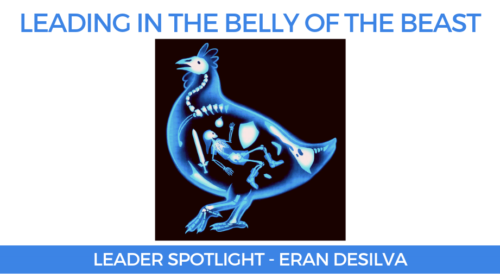Monthly Leader Spotlight – Eran DeSilva (Leading in the Belly of the Beast)
What does it mean to lead in the belly of the beast, and what do you do about it? Hear what Eran DeSilva has learned through her leadership and teaching experience.
This is the second of 8 Leader Spotlights, all focusing on leadership in an oppressive system. These 8 leaders and I are working on a book about leading for social justice, due to release in 2020. Each month, I will feature one brave leader, and give space for them to share their reflections, inspirations, and preview of their chapter.
Eran DeSilva: Director of Professional Development and Social Studies Teacher, Notre Dame High School

Eran with Abby Johnson, a former student who is now teaching with her
When did you realize you were in the belly of the beast?
In my first back to school night 19 years ago, I shared with my students’ parents, “I am teaching because I want to change the world. Education will transform and empower students to be that change.” My 22 year old self was a new teacher who was idealistic and naive, but also earnest and committed. I truly believed that I was going to radically change lives and communities. My work in education nearly two decades later is still wed to this ideal of empowerment and social change – but my understanding of the scope of the work is more mature and more nuanced.
What I did not understand when I first started out teaching, was that I was in an inherently unjust education system that is designed to sort and track students. As my colleague and co-author Milton Reynolds, wrote, “Schools are not actually broken. They do exactly what they were designed to do and they do it well, it’s just not what we need them to do at this point in time. Rather than identifying and sorting students, we need schools that inspire, engage, and uplift.” (from Discipline Over Punishment: Successes and Struggles with Restorative Justice in Schools, by Trevor Gardner xii)
So now what? How do you stay in a system that perpetuates the inequities that you so strongly oppose and try to dismantle?
By keeping students in the center of my work. Always. In the midst of juggling all of the responsibilities of a teacher or school leader, I try to stay grounded in what students are thinking, feeling, and saying. My students have to be co-learners, co-constructors, and co-liberators in the creation of a more just, compassionate world. Because my students hold so much power and insight into our world.
Just consider the issue of race…
Chapter Summary
Our students hold incredible capacity and potential for navigating the current explosive racial crisis America faces. I witness this every year when I teach the unit on Race, Identity, and Community in my Contemporary Social Issues course. To set the stage and norms for the conversations, I ask seniors “Why is it hard to talk about race?” Hands shoot up and they eagerly share their opinions: It’s uncomfortable. It’s taboo. You are afraid of offending someone. You are afraid of being hurt. You might say something racist. I might have to call someone else out for being racist. They unabashedly share their feelings before diving into the study of race in America.
But when I ask adults, “Why is it hard to talk about race?” and the quiet discomfort is palpable. There is silence or hesitant responses. There is fear of conflict or misunderstanding. I am always struck by how starkly different the tone and engagement is between student and adults. What can students teach adults about tackling the issues of racism? They have grown up in a color-conscious environment rather than with color blind frameworks. So in some ways, they are more equipped to talk more openly about identity than we are.
Last year I was fortunate to be part of the editing team for two amazing young women named Winona Guo and Priya Vulchi. They had a passion for learning about race and identity in America. They wanted to write a book to help develop racial literacy and equip communities to have conversations about identity and belonging. So after graduating from high school traveled across the country to collect stories from diverse individuals so they could tell a story about our collective American identity and understanding of race. Their book Tell Me Who You Are: Sharing our stories about race, culture, and identity comes out tomorrow. These two young women, like so many of our students, are bold and care deeply about their learning and making the world a more just place. Let’s bring them into the conversation about how to make learning space more inclusive, more relevant, and more engaging.

What are you reading these days and which leaders have influenced your work?
Leading from the belly of the beast means amplifying our students’ voices and giving them a seat at the table. Let students be our teachers. Let them show us how to be resilient, brave, and radical.
Right now I am reading, Grading for Equity by Joe Feldman as well as This Will be My Undoing: Living at the Intersection of Black, Female, and Feminist in (White) America” by Morgan Jerkins

Links and Resources
Claude Steele’s work on stereotype threat and identity safety has had a huge impact on my work.
If you haven’t already read, “Whistling Vivaldi: How Stereotypes Affect Us and What We Can Do” – you need to pick it up!


